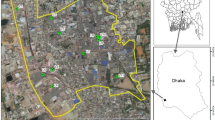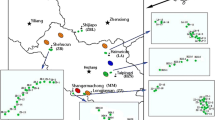Abstract
Heavy metals pollution in pharmaceutical industries received increasing attention. A total of 94 soil samples were collected in this study. Results showed the mean contents of Hg, Cd, As, Pb, Ni and Cu were 0.21, 0.26, 9.59, 55.06, 51.52 and 50.81 mg·kg−1, respectively. The spatial distribution of metals in topsoil largely attributed to the pharmaceutical production process. The distribution of Hg and As were related to the production of medical absorbent cotton. While Ni was related to the fuel supply of Ni-rich coal. Cr, Cu and Pb mainly distributed in the process which they were used as catalysts. The vertical migration of metals was complex in soil. To a great extent, it was related to the texture of the soil and the properties of metals in this filed. The total non-cancer and cancer human health risk were within the limits of USEPA (10–6 a−1). This demonstrated the health risks of individual’s exposure to heavy metals in this factory was acceptable.




Similar content being viewed by others
References
Arienzo M, Ferrara L, Toscanesi M, Giarra A, Donadio C, Trifuoggi M (2020) Sediment contamination by heavy metals and ecological risk assessment: the case of gulf of Pozzuoli, Naples, Italy. Marine Pollut 155:111149
Asgari K, Cornelis WM (2015) Heavy metal accumulation in soils and grains, and health risks associated with use of treated municipal wastewater in subsurface drip irrigation. Environ Monit Assess 187(7):410–423
Beattie RE, Henke W, Davis C et al (2017) Quantitative analysis of the extent of heavy-metal contamination in soils near picher, Oklahoma, within the tar creek superfund site. Chemosphere 172:89–95
Cempel M, Nikel G (2006) Nickel: a review of its sources and environmental toxicology. Pol J Environ Stud 15(3):375–382
Chabukdhara M, Nema AK (2013) Heavy metals assessment in urban soil around industrial clusters in Ghaziabad, India: probabilistic health risk approach. Ecotoxicol Environ Saf 87:57–64
Chen HY, Teng YG, Lu SJ, Wang YY, Wang JS (2015) Contamination features and health risk of soil heavy metals in China. Sci. Total Environ 512:143–153
Ciszewski D, Aleksander-Kwaterczak U, Pociecha A et al (2013) Small effects of a large sediment contamination with heavy metals on aquatic organisms in the vicinity of an abandoned lead and zinc mine. Environ Monit Assess 185:9825–9842
Duan X (2017) The research method of the exposure parameters and its application in the environmental health risk assessment. Science Limited Liability Company, Beijing
Energy(Doe) UDO (2011) The risk assessment information system(Rais). U.S. Department Of Energy’s Oak Ridge Operations Office(Oro)
Ferreira V, Koricheva J, Duarte S et al (2016) Effects of anthropogenic heavy metal contamination on litter decomposition in streams–a meta-analysis. Environ Pollut 210:261–270
Gregory S, Udie OA, Ozibo BN (2018) Chemical speciation and complexation modeling of trace and rare earth elements in groundwater of Oban massif and Mamfe mMbayment Southeastern Nigeria. Chem Speciat Bioavail 30:86–98
Gutierrez C, Fernandez C, Escuer M et al (2016) Effect of soil properties, heavy metals and emerging contaminants in the soil nematodes diversity. Environ Pollut 213:184–194
He J, Chen JP (2014) A comprehensive review on biosorption of heavy metals by algal biomass: materials, performances, chemistry, and modeling simulation tools. Biores Technol 160:67–78
Jahromi MA, Jamshidi-Zanjani A, Darban AK (2020) Heavy metal pollution and human health risk assessment for exposure to surface soil of mining area: a comprehensive study. Environ Earth Sci 79:365
Kaur R, Bhatti SS, Singh S et al (2018) Phytoremediation of heavy metals using cotton plant: a field analysis. Bull Environ Contam Toxicol 101:637–643
Khademi H, Gabarron M, Abbaspour A et al (2019) Environmental impact assessment of industrial activities on heavy metals distribution in street dust and soil. Chemosphere 217:695–705
Kulawik P, Dordevic D, Gambuś F et al (2018) Heavy metal contamination, microbiological spoilage and biogenic amine content in sushi available on the polish market. J Sci Food Agric 98:2809–2815
Lebron AMW, Torres IR, Valencia E et al (2019) The state of public health lead policies: implications for urban health inequities and recommendations for health equity. Int J Environ Res Public Health 16:1064–1070
Lee B-K (2011) Occupational health management in the lead industry: the Korean experience. Saf Health Work 2:87–96
Liu S, Qi X, Han C et al (2017) Novel nano-submicron mineral-based soil conditioner for sustainable agricultural development. J Clean Prod 149:896–903
Machender G, Dhakate R, Prasanna L et al (2011) Assessment of heavy metal contamination in soils around balanagar industrial area, Hyderabad, India. Environ Earth Sci 63:945–953
Mehmood A, Aslam Mirza M, Aziz Choudhary M et al (2019) Spatial distribution of heavy metals in crops in a wastewater irrigated zone and health risk assessment. Environ Res 168:382–388
Michalek IM, Martinsen JI, Weiderpass E, Hansen J, Sparen P, Tryggvadottir L, Pukkala E (2019) Heavy metals, welding fumes, and other occupational exposures, and the risk of kidney cancer: a population-based nested case-control study in three Nordic countries. Environ Res 173:117–123
Mugosa B, Dijana D, Aleksandra P et al (2015) Children’s health risk assessment based on the content of toxic metals Pb, Cd, Cu and Zn in urban soil samples of Podgorica, Montenegro. Vojnosanit Pregl 72:807–812
Olawoyin R, Oyewole SA, Grayson RL (2012) Potential risk effect from elevated levels of soil heavy metals on human health in the Niger delta. Ecotoxicol Environ Saf 85:120–130
Ozkul C (2016) Heavy metal contamination in soils around the Tuncbilek thermal power plant (Kutahya, Turkey). Environ Monit Assess 188:284–290
Rachwał A, Kardel K, Magiera T et al (2017) Application of magnetic susceptibility in assessment of heavy metal contamination of saxonian soil (Germany) caused by industrial dust deposition. Geoderma 295:10–21
Rastegari Mehr M, Keshavarzi B, Moore F et al (2017) Distribution, source identification and health risk assessment of soil heavy metals in urban areas of Isfahan province. Iran J Afr Earth Sci 132:16–26
Rasmussen PE, Subramanian KS, Jessiman BJ (2001) A multi-element profile of house dust in relation to exterior dust and soils in the city of Ottawa, Canada. Sci. Total Environ 267(1–3):125–140
Ren W, Wu W, Chen Y et al (2017) Assessment of heavy metal pollution in soil from an abandoned chemical plant. J Hefei Univ Technol 40:533–538
Usepa (2004) Risk assessment guidance for superfund volume 1: human health evaluation manual. Part E: supplemental guidance for dermal risk assessment. Office of Superfund Remediation and Technology Innovation
Wang T, Deng Q (2018) Study on distribution, form and bio-availability of lead, chromium and cadmium in superphosphate production process. Jiangsu Agric Sci 46:222–226
Wang S, Wu W, Liu F (2019) Assessment of the human health risks of heavy metals in nine typical areas. Environ Sci Pollut Res 26:12311–12323
Wang SY, Kianpoor Kalkhajeh Y, Qin ZR, Jiao WT (2020) Spatial distribution and assessment of the human health risks of heavy metals in a retired petrochemical industrial area, south China. Environ Res 188:109661
Wei Y, Li Y, Wang Z (2019) Evaluation of soil heavy metal pollution in a chemical plant after relocation. Land Dev Eng Res 4:63–68
Wu C (2013) Green synthesis of Dimethyl Malonate. East China University of Science and Technology. Shanghai. Spatial
Wu H (2017) Heavy metals pollutions study and health risk assessment in soil of a demolished chlor-alkali plant. Nanchang University China
Xu F (2016) Green synthesis technolgy of dimethyl malonate. East China University of Science and Technology, Guangzhou
Yang S, Wang J, Li HG et al (2018) Pollution characteristics and health risk assessment of heavy metals in green space of Chongqing city. Chin J Soil Sci 49(4):966–972
Yuan C, Pan Z, Tan Z (2017) Synthesis of ordered mesoporous alumina and its application in preparation of heavy metal tolerance FCC catalyst. Petrol Processing Petrochem 48(5):52–55
Zheng S (2013) Spatial distribution and pollution assessment of mercury in soil at a contaminated site: a case study of mercury cell chlor-alkali plant in Yanguoxia. Lanzhou University Lanzhou, Gansu
Acknowledgements
This work was supported by the National Key Research and Development Plan (Grant No. 2018YFC1802106) and China Postdoctoral Science Foundation Funded Project (Grant No. 2019M660822).
Author information
Authors and Affiliations
Corresponding authors
Ethics declarations
Conflict of interest
The authors declare that they have no known competing financial interests or personal relationships that could have appeared to influence the work reported in this paper.
Additional information
Publisher's Note
Springer Nature remains neutral with regard to jurisdictional claims in published maps and institutional affiliations.
Supplementary Information
Below is the link to the electronic supplementary material.
Rights and permissions
About this article
Cite this article
Wang, S., Ma, Z., Yue, G. et al. Spatial Distribution and Assessment of the Human Health Risks of Heavy Metals in a Retired Pharmaceutical Industrial Area, Southwest China. Bull Environ Contam Toxicol 109, 808–816 (2022). https://doi.org/10.1007/s00128-022-03503-9
Received:
Accepted:
Published:
Issue Date:
DOI: https://doi.org/10.1007/s00128-022-03503-9




